Expert’s Rating
Pros
- Strong battery life
- Very tidy design for the money
- Bright, crisp display
- Relatively clean software
Cons
- Very sluggish performance
- Software bloat creeping in
- Display only a 60Hz LCD
Our Verdict
Motorola has turned out a well-built phone for less than £150, but in some ways, the Moto G15 feels like poor value. It’s incredibly slow, packs an underwhelming display, and Motorola’s software isn’t the strong suit it used to be.
Price When Reviewed
This value will show the geolocated pricing text for product undefined
Best Pricing Today
Smartphones are expensive, with even our current pick for the best budget smartphone costing more than £200.
The value proposition of your average handset is undeniable – these things pretty much run every aspect of our lives – but laying down hundreds of pounds on anything is a big ask for many people. That’s where phones like the Moto G15 come in.
For just under £140, Motorola is offering you all the basics of smartphone ownership: a large and suitably sharp display, an adequate camera, a large battery, and even a reassuringly classy design.
Why would you want to splash out for anything more? As ever with such money saving propositions, the devil is in the detail, and you largely get what you pay for. Here’s my full review.
Design & Build
- Classy, modern Motorola design
- Grippy faux-leather back
- IP54 certification
Motorola has more experience making high quality cheap phones than anyone. Its Moto G series has been a go- to name for reliable budget handsets for years now.
That’s why it’s capable of making a phone like the Moto G15 – a solidly built, classy looking handset that looks (from certain angles) very much like phones that sell for double the money.

Jon Mundy / Foundry
Motorola has used its modern day design language here. From the back the Moto G15 looks exactly like the Moto G85, and even the £600 Moto Edge 50 Pro.
You have the same gently bulging camera module, and even a familiar faux-leather material that aids grip and minimises paw prints. You won’t find another sub-£150 phone that feels this good.
My test model comes in a sober shade of Gravity Grey, but you can specify something more eye-catching in the form of Iguana Green and Sunrise Orange.
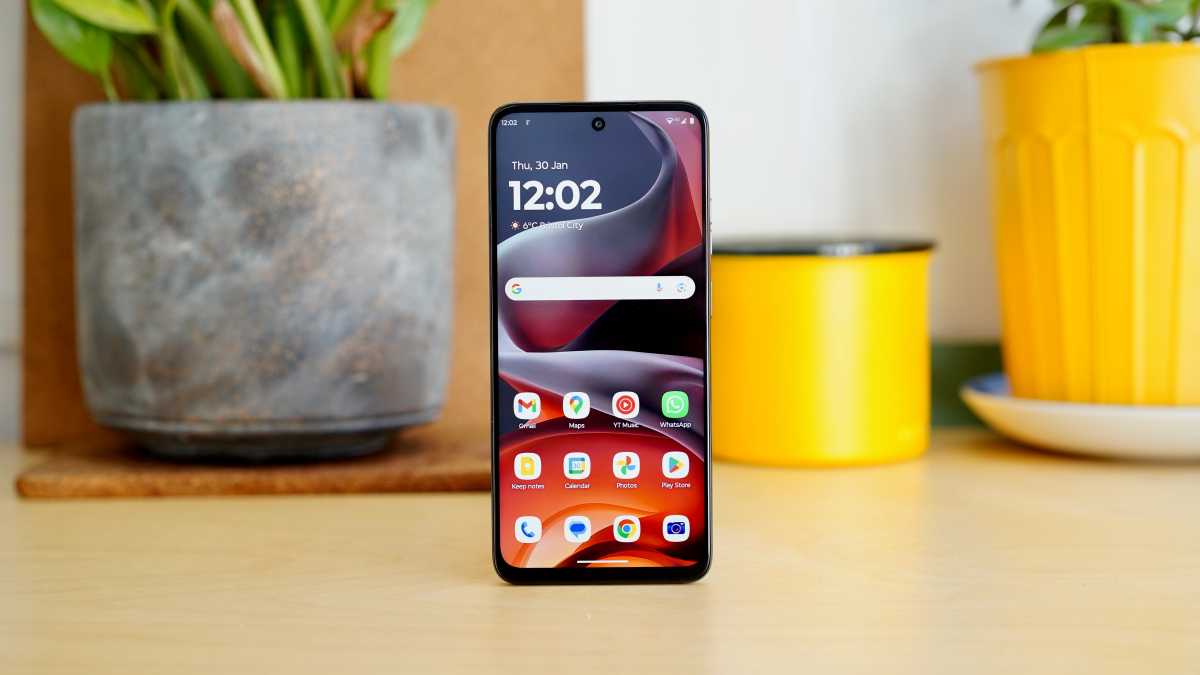
Jon Mundy / Foundry
From the front, things are slightly less impressive, which huge display bezels and a ginormous chin. Still, at least you get a proper hole punch notch, rather than the dated teardrop solution that some cheap phones persist with.
You won’t find another sub-£150 phone that feels this good
It’s not a small phone by any means, with dimensions of 165.67 x 75.98 x 8.17mm and a weight of 190g belying its all-plastic materials. Sure enough, have to really go some to make it flex or creak, and the provision of IP54 dust and water resistance is pretty good for the money.
Screen & Speakers
- 6.72-inch LCD display
- FHD+ resolution
- Only 60Hz refresh rate
- Stereo speakers with Dolby Atmos support
One of the first indicators that you’re dealing with a very cheap phone comes when you first boot the screen up. Besides the aforementioned chunky bezels, it soon becomes apparent that you’re dealing with an LCD panel, as opposed to the OLED you’ll find on the vast majority of phones over £200.
Without the vibrant properties of OLED, media content looks somewhat washed out here, with murky greys taking the place of deep blacks, and a relative lack of contrast.
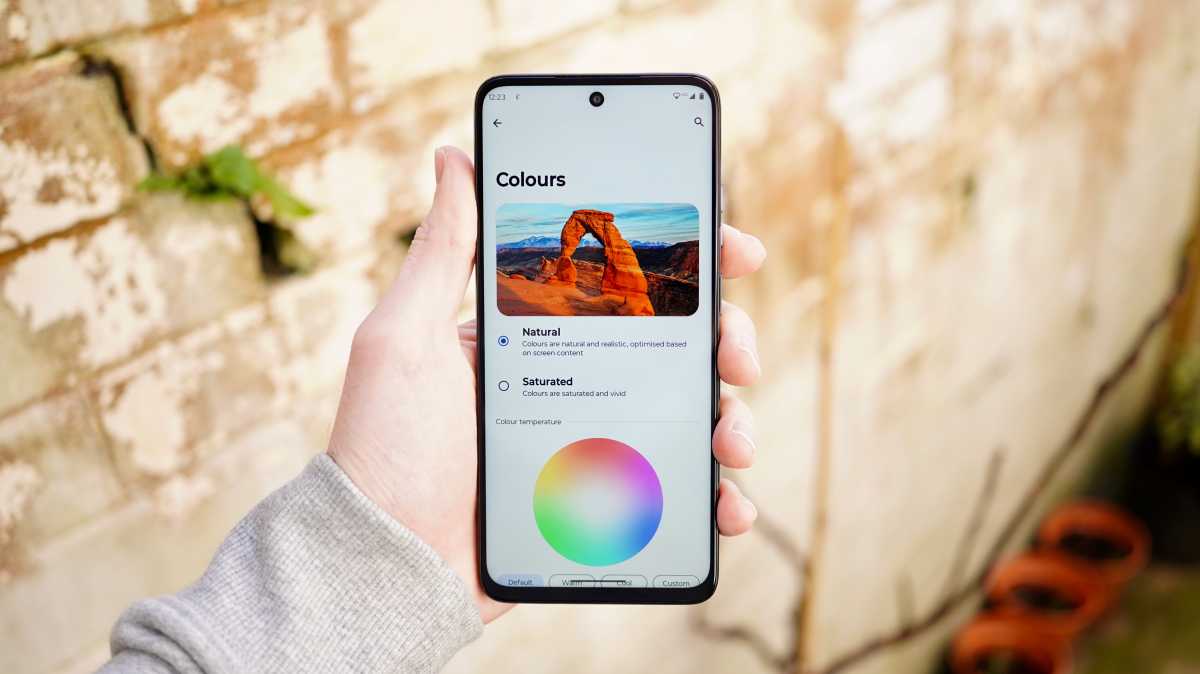
Jon Mundy / Foundry
Motorola has commendably still been able to implement an ambient display of sorts, so you can see the time and any notification indicators when you tap the screen, but it’s achieved by making the display almost unusably dim.
While the Moto G15’s screen is somewhat hobbled from the off, it does have the benefit of being big (6.72 inches) and sharp (1080 x 2400, FHD+), the latter of which isn’t a given when you’re spending less than £150.
Media content looks somewhat washed out here, with murky greys taking the place of deep blacks, and a relative lack of contrast
It also gets reasonably bright, with an Extra Brightness option lending even more on sunny days, should you need it.
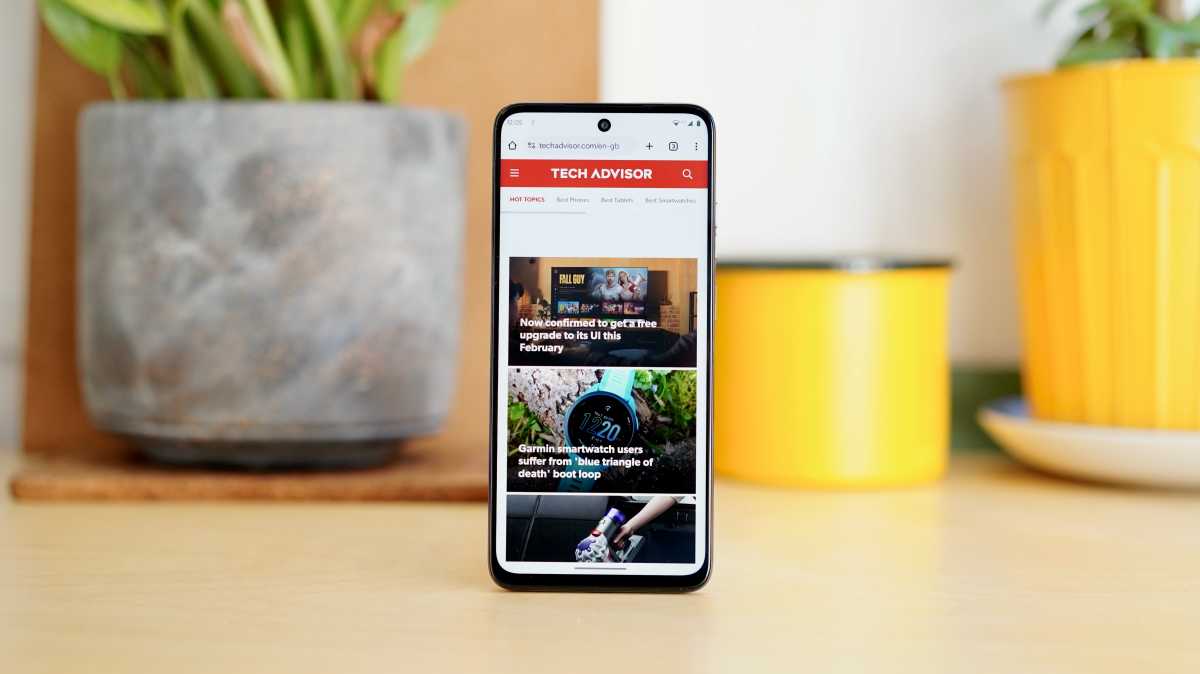
Jon Mundy / Foundry
The only real bum note here, considering the money you’re paying, is the provision of a mere 60Hz refresh rate. Unless you’re Apple, this feels like a specification from another era entirely.
Viewed from another perspective, however, I suggest that this is a sensible provision given the limited nature of the Moto G15’s processor. What’s the point of a smooth display if the phone is struggling with simple tasks?
The Moto G15’s audio provision is surprisingly strong. You get proper stereo speakers, along with support for Dolby Atmos and a hint of Bass Boost. You’ll still want to hook up a set of headphones (there’s an old school 3.5mm jack if that’s your preference) when possible, but there’s a fair amount of depth and separation for a phone of this price.
Specs & Performance
- MediaTek Helio G81
- 4GB LPDDR4X RAM
- 128GB storage plus MicroSDXC expansion
In many of the ways that count, Motorola has worked its limited budget successfully to give you a solid approximation of a modern smartphone experience. But it evidently had to draw the line when it came to performance, and it ultimately proves the Moto G15’s undoing.
Chipsets contribute a fair amount to the bill of materials, so Motorola has been forced to compromise with a humble MediaTek Helio G81. This creaky 12nm component simply isn’t up to the task of driving a modern phone fluidly, even with the display stuck at a mere 60Hz. The provision of just 4GB of RAM can’t help here.
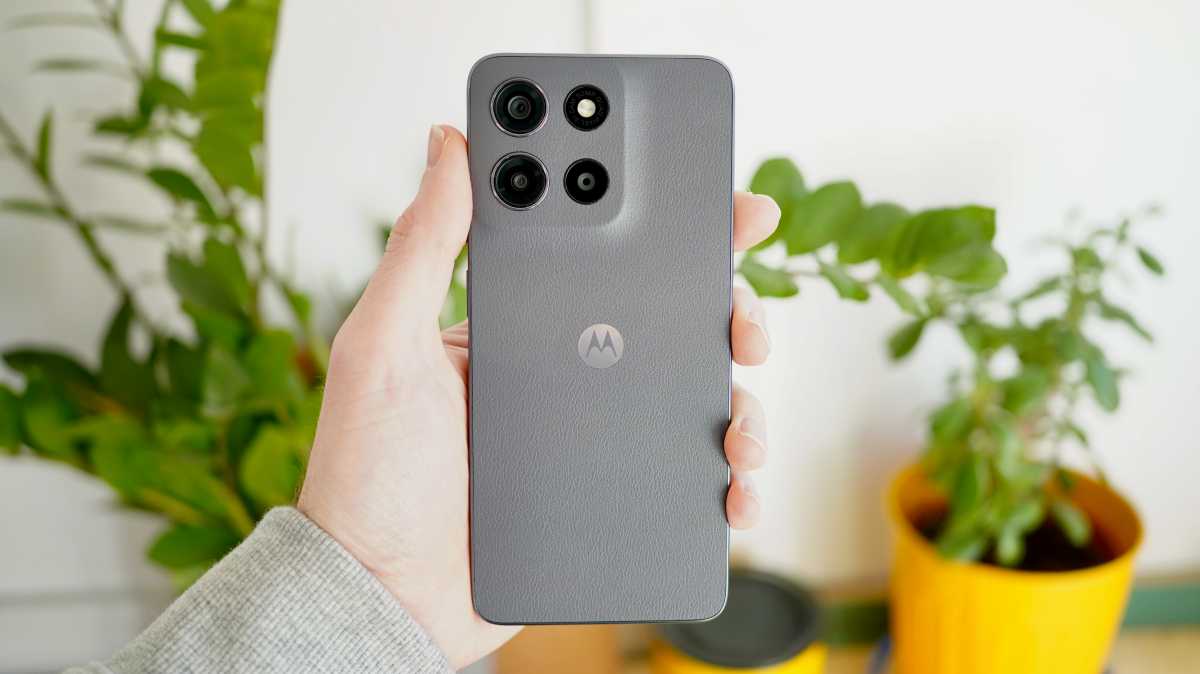
Jon Mundy / Foundry
Using the Moto G15 will be a painful experience for anyone used to something more. And I’m not even talking about flagship phones here, but rather anything retailing for around £250.
The simple act of flitting between home screens and menus is accompanied by a noticeable amount of chug and stutter; loading media-rich websites takes an extra beat or two; and jumping into the camera app using Motorola’s double twist gesture seems to take an age.
Using the Moto G15 will be a painful experience for anyone used to something more
Our benchmark tests back this up, with a Geekbench 6 multi-core result that falls 50% short of even the humble Samsung Galaxy A16 5G – not a level of performance that any phone would wish to aspire to.
GPU performance is even worse, with the Moto G15 achieving around half the frame rate of the Galaxy A16 5G (and indeed the older Galaxy A15 5G and A14 5G). It can’t even match the year-old Moto G04 with its sub-£100 RRP.
Motorola Moto G15 benchmarks
Cameras
- 50Mp main camera
- 5Mp ultrawide
- 8Mp selfie camera
If Motorola has failed to make a phone that punches above its weight in performance terms, it has at least supplied a camera system that can produce acceptable results for the money.
It’s gratifying to see that the company has avoided the pointless frippery of gimmicky extra sensors here. You simply get a 50Mp f/1.8 main sensor and a 5Mp ultra-wide, with no silly stat-padding macro camera or depth sensor in sight.
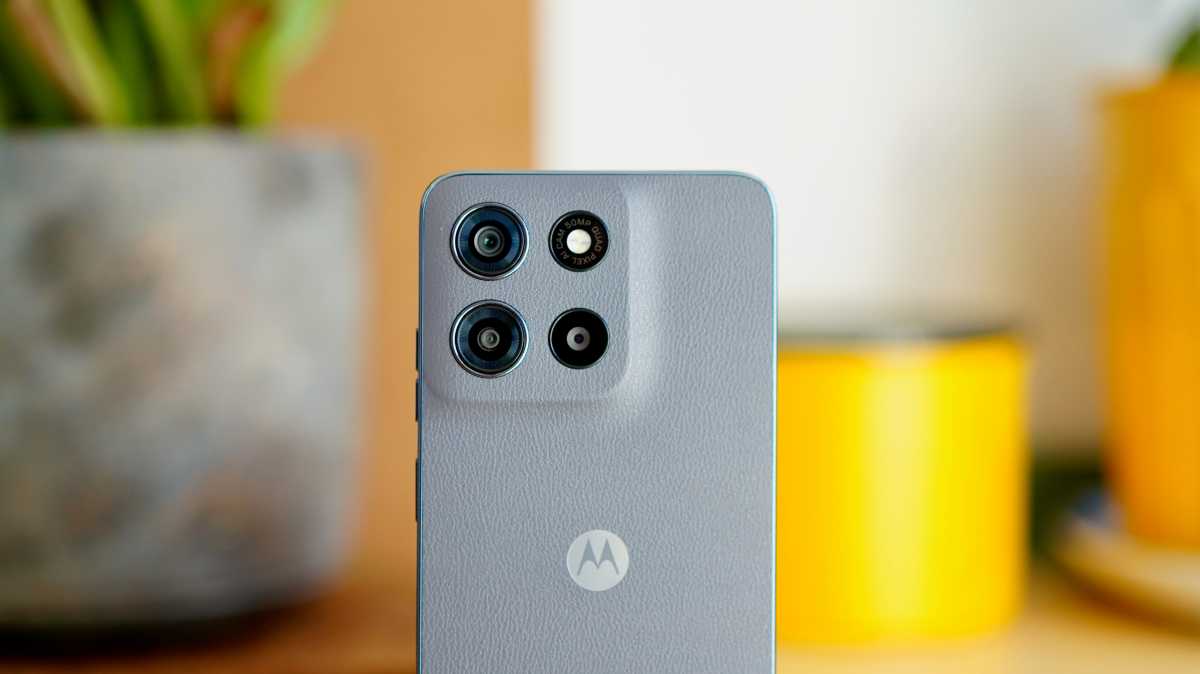
Jon Mundy / Foundry
The main camera won’t impress anyone who’s used a phone in the £200 or higher range before, but nor does it disgrace itself. In good lighting, the G15 produces acceptable – that is, shareable – snaps that handle exposure and implement auto-HDR adequately. The colour tone is reasonably natural, and I was quite happy with skin tones and indeed a dedicated portrait mode that separates the subject reasonably well.
The main camera won’t impress anyone who’s used a phone in the £200 or higher range before, but nor does it disgrace itself
Food shots in a well lit restaurant produced tasty-looking, natural phots, but as soon as the light dropped further things soon fell apart. Night mode seems wholly inadequate here. While it compensates for the lack of brightness, the noise levels are extreme.
The 5Mp ultra-wide is a very poor performer, exhibiting a pronounced drop off in detail, evident signs of overexposure, and a generally more over-processed colour tone.
The 8Mp selfie camera isn’t up to much either. The tone is on point, but I noticed an unpleasant over-sharpened effect on my face.
Video capture, meanwhile, maxes out at a meagre 1080p and 30fps. The lack of OIS proves troublesome, as it does with those night shots.
Battery Life & Charging
- 5200mAh battery
- 18W wired charging
- No charger in box
Motorola has gone a little further than usual with its battery provision, packing the Moto G15 out with a 5200mAh cell.
Together with such a humble 60Hz display and a low-power (if not hugely efficient) processor, it’s enough to grant the Moto G15 two days of usage with light to moderate usage. Which, as we’ve discussed, is likely all you’ll want to be subjecting the phone to.
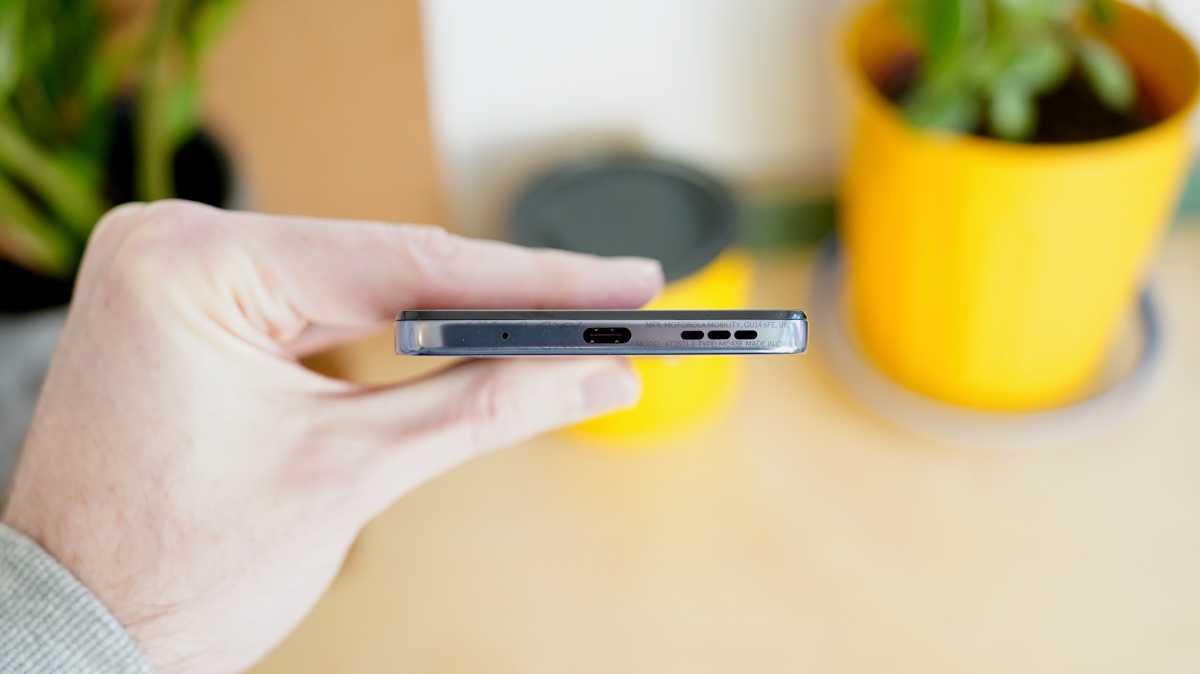
Jon Mundy / Foundry
In a day of moderate usage, with around 3 hours and 20 minutes of screen on time, I found that I was left with between 50 and 60% left – more than enough to sustain me through a whole second day.
Not that it’s all good news on the stamina front. In the PCMark World 3.0 battery test, which simulates battery load under mixed working environment, the Moto G15 lasted just 11 hours and 38 minutes. That’s a little better than the Samsung Galaxy A16 5G, but several hours less than the CMF Phone 1, and more than an hour less than the Poco X7.
The phone supports up to 18W wired charging, but you’ll need to supply your own power brick. Using a suitable third party charger, it took a rather ponderous 45 minutes to get from empty past the half way mark, and just shy of 1 hour 45 minutes for a full charge.
With around 3 hours and 20 minutes of screen on time, I found that I was left with between 50 and 60% left – more than enough to sustain me through a whole second day
Software & Features
- Android 15
- Close to stock UI
- Only two years of software updates
Motorola’s software is famously lightweight and refined, and Android 15 is permitted to do its thing largely without interference here.
Menus and icons are all largely as Google intended, though I’m not a huge fan of the default font Motorola has gone with. It doesn’t provide much visual differentiation between bold and regular text, which makes the Gmail inbox tough to navigate.
Unfortunately, there are some unwelcome signs of intervention from Motorola as well. On the Moto G15, I was quite irritated to have the New Apps service foisted upon me.
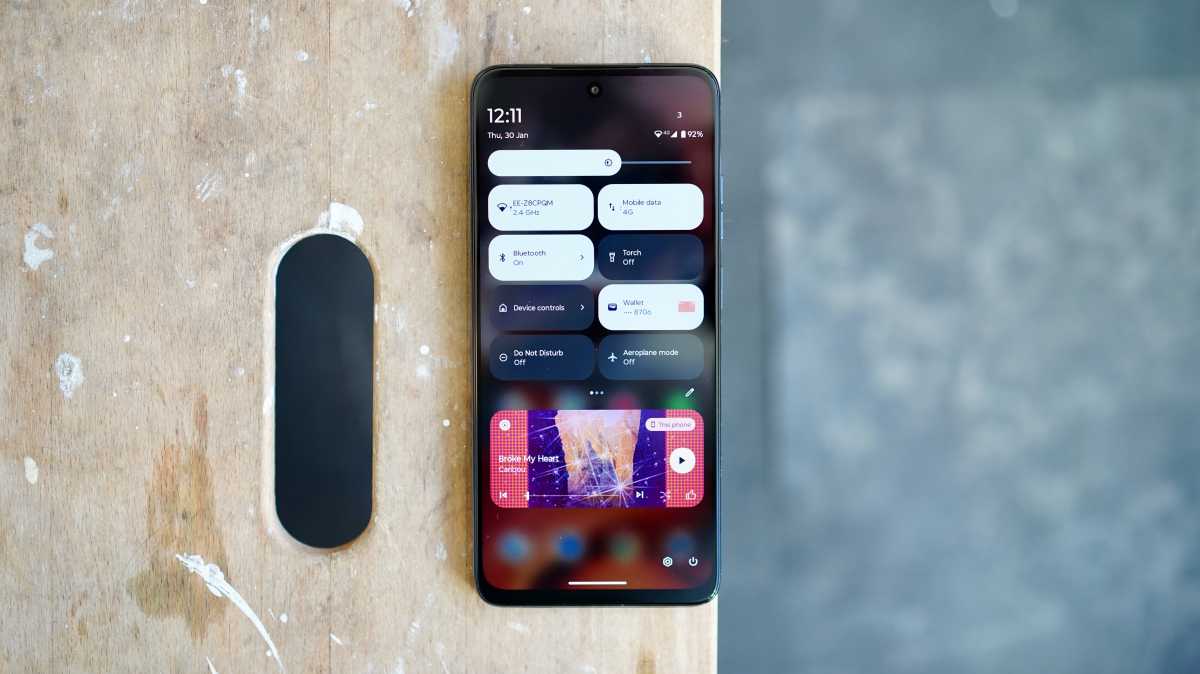
Jon Mundy / Foundry
The positioning of this service seems a little disingenuous. “Try three apps that are new to you, delivered monthly and with system updates” reads the blurb. Sounds positively helpful, no?
What it actually amounts to is a thinly veiled extra revenue stream for Motorola. The first three apps that I was furnished with under the initiative were cheap and cheerful shopping app Temu and two terrible games – three apps that could scarcely be further from what I would choose for myself.

Jon Mundy / Foundry
Motorola was annoyingly insistent with this too, bombarding me with notifications to try the New Apps service immediately from set-up. Add this to a bunch of regular bloat – Booking.com, Faceboook, Opera, more bad games – and this isn’t quite the super-clean UI we once knew.
From what I’ve read, Motorola’s update plan isn’t too hot here either. No further Android versions are promised, along with only two years of security patches.
This isn’t quite the super-clean UI we once knew
Motorola’s UI remains one of the nicest to use in the entire budget phone space, but it’s not quite the out and out plus point it used to be.
Price & Availability
The Moto G15 is available directly from the Motorola website, as well as third party retailers such as Amazon and Argos, for a price of just £139.99.
No UK networks are offering the device on contract, so you’ll have to pair it with a SIM deal. And there’s no availability in the US whatsoever, unless you’re willing to risk importing one.
Interestingly, that outright price doesn’t make it one of the very cheapest phones on the market. Motorola itself sells the Moto E15 for just £70, for example.
However, this is still downright cheap in our books, with most mainstream budget phones tending to be released around the £200 mark.
At this sub-£150 price, the Moto G15 only has a small selection of rivals, including the Xiaomi Redmi 14C and the Oppo A40, both of which retail for £129. The 4G version of the Galaxy A16 is also worth considering, though it’s £169.
Should you buy the Moto G15?
The Moto G15 isn’t a particularly good phone, but it’s also not a particularly bad sub-£150 phone. In fact, with its pleasant design, clean UI, decent battery life, and big sharp screen, there’s a lot to like.
But the performance is distinctly sub-par, the display isn’t fluid or OLED, and there are even a couple of annoying elements to Motorola’s usually well-judged software – including a poor update promise. Meanwhile, the camera and battery life are perfectly adequate, but certainly nothing to write home about.
If the Moto G15 indicates anything, it’s that spending less than £200 on a brand new phone isn’t such good value as it might seem to be. You’re better off spending the same money on an older but more premium phone instead.
Specs
- Android 15
- 6.72-inch, FHD+, LCD, 60Hz, flat display
- Side-mounted fingerprint sensor
- MediaTek Helio G81
- 4GB LPDDR4X RAM
- 128GB storage
- 50Mp, f/1.8 main camera
- 5Mp, f/2.4 ultra-wide camera
- Up to 1080p @ 30fps rear video
- 8Mp front-facing camera
- Stereo speakers
- Dual-SIM
- Wi-Fi 802.11 a/b/g/n/ac
- Bluetooth 5.0
- 5200mAh battery
- 18W charging
- 165.67 x 75.98 x 8.17 mm
- 190g
- Launch colours: Gravity Grey, Iguana Green, Sunrise Orange








